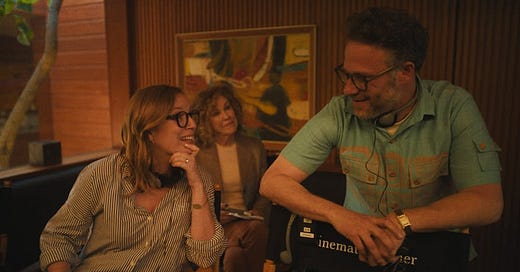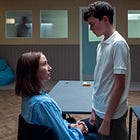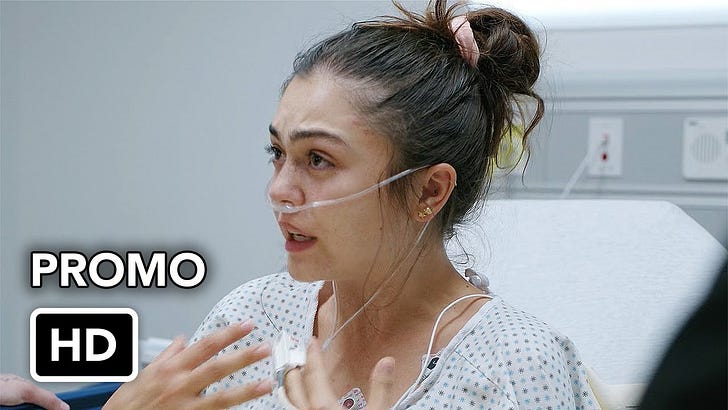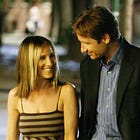Scene Study: 'The Studio'
In search of one perfect take on Seth Rogen and Evan Goldberg's Apple series.
You know who’s cool? Orson Welles.
Everyone knows Welles from his all-time classic, the Intro to Film Studies assigned viewing Citizen Kane, but cinephiles pondering Welles may first think of the legendary tracking shot that opens his scuzzy noir classic Touch of Evil, in which the camera drifts past a bomb hidden in a car trunk to Charlton Heston’s Mexican lawman. For sheer cinematic panache, for the sheer exuberant joy of watching a filmmaker use the tools of their trade with maximal efficiency, beauty, and technical skill, it is hard to top Touch of Evil, which is precisely why filmmakers have spent the last 65 years attempting to beat it anyway.
Last week, we wrote about Adolescence, whose entire four-episode run is turned over to single-take pyrotechnics, but the feel was as much theatrical as cinematic, with the camera restlessly circling its protagonists, or following one character from one carefully produced space to the next. What are the odds that there would be two series, premiering at roughly the same time, looking to pull off the same trick?
Created by Seth Rogen and Evan Goldberg, best known for collaborating on Superbad and Pineapple Express, The Studio is a 21st-century update of that familiar cinematic subgenre: the Hollywood satire. Movies making fun of the sausage-makers date back to the likes of What Price Hollywood? from 1932, but The Studio has in its sights more recent shots of acid like Robert Altman’s The Player. (Bryan Cranston’s studio boss here is even named Griffin Mill, after Tim Robbins’ character from that film.)
Rogen plays Matt Remick, an impassioned cinephile who is named president of a studio in turmoil, and finds that he has to sell out most of his most cherished ideals to stay in the job. Matt dreams of hiring Martin Scorsese to make his dream project, and instead finds himself seeking to employ the director of Raging Bull to adapt the Kool-Aid IP for the movies. (Will Scorsese’s Kool-Aid be a worthy successor to Greta Gerwig’s Barbie? These execs would love to know.) In an era dominated by the likes of A Minecraft Movie and The Super Mario Bros. Movie, satire is hard.
The era of great movies is long over, The Studio tells us, and well-meaning nonentities like Matt are present only to desecrate Hollywood’s rotting corpse, which could never and would never employ another Welles, or make another Touch of Evil. All of which goes to make The Studio’s second episode, “The Oner,” a complex, layered joke about what to do with all that free-floating inspiration, panache, and sheer filmmaking audacity that cinephiles hold near their hearts, and that has nowhere to go in the era of Captain America: Brave New World.
As with all tragedies, this one begins from an overabundance of idealism. Matt and his henchman and second-in-command, Sal Saperstein (Ike Barinholtz), are racing to a set where the final shot of an in-progress film by a lauded auteur (Sarah Polley, playing a version of herself) is about to be shot during the magic hour. “It’s gonna be, like, a famous shot in a movie. I want to be there when they film it!” Matt tells Sal. Matt believes that the great privilege of his new position is to observe great filmmakers at work, and he and Sal race through the streets, bypassing the production’s traffic stop and pulling up right next to the house where the shoot is taking place. The director plans a complex tracking shot for the film’s final scene that will follow its protagonist as she walks along an elegant swimming pool, kisses her girlfriend, gets in her car, and drives away.
“It’s just the director jacking off while making everyone’s lives miserable. Audiences do not care about this shit,” Sal complains, setting off another film-snob tantrum from Matt, who shouts out Birdman, Children of Men, and Goodfellas as exemplars of the form. Matt really knows movies. He compares being present for Sarah’s oner to not only Touch of Evil, but being on the streets of Cuba for the funeral sequence in Mikhail Kalatozov’s I Am Cuba—a real film-nerd gem.
Matt cannot stop enthusing about film history, and is blissfully unaware that in doing so, he is keeping Sarah from adding to that history. Matt only wants to be a fly on the wall as greatness takes place, but the entire thrust of the joke is that he cannot get out of his own way. “His film boner is at full mast,” Patty (Catherine O’Hara) tells Sarah by way of apology. He absent-mindedly requests a coffee that delays the production. He insists on changing his clothing to appear more casual, accidentally borrowing much-needed clothing for the shot from the wardrobe department. He offers a note to Sarah even as Sal attempts to tackle him to prevent him from offering his opinion, suggesting that the protagonist hold the joint she had in an earlier scene, which she reluctantly takes, hoping Matt will greenlight the cost of the Rolling Stones’ “You Can’t Always Get What You Want” for the scene.
And all the while, the camera dips and dives, pauses and darts, jutting and veering among stars and directors, crew members and extras, and all the piled-up detritus and décor of this single crucial shot.
The first take is interrupted by the joint going out. Matt is concerned about a technical snafu, and his sotto voce complaints mess up the next take. Matt suggests stitching a take together or using whip-pans a la Sam Mendes’ 1917, and Sarah begins to get testy: “It’s a true oner. There’s no tricks. We’re just gonna do it.”
“Pretend I’m not here,” Matt keeps saying, but no one can.
His very presence causes the nervous crew to serve him rather than capture the shot. Matt goes to the bathroom as the crew scrambles, and picks up the thread of a conversation he had been holding with the film’s star Greta (Greta Lee), not realizing he has interrupted her midshot. Greta points to the camera behind him, and Sarah lets out a banshee yell from the far background of the shot. Matt runs off, crashes into a table, and bloodies his nose, all the while refusing any attention, including from the on-set medic. And all the while the light is dissipating, and the one chance they have to capture this shot is slipping away.
The studio boss is literally, and not only metaphorically, damaging the tenuous possibility of creating anything even remotely resembling cinema. What makes “The Oner” so funny is that no one is angrier about it than Matt, who wants nothing more than to be quietly present as skilled artists pull off making something beautiful. But by his very presence, simply by the person he is, he cannot help but prevent this gorgeous shot—which we keep seeing unspool in part—from being completed.
There is time for one more take. Lee struts purposefully past the pool once more, and we watch on the monitors. It is, as promised, a gorgeous shot. We anxiously keep an eye on Matt in the hope that he will not fuck it up yet again. He appears to be staying in place, and the stars seem to have lined up, after so many false starts and failures. Lee kisses her girlfriend, she gets in her car, and then—aha!—the driveway is blocked by our dipshit’s car. Matt and Sal are ordered to vacate the set, and they drive away at top speed, reversing the journey that started the episode, with Matt hoping that the waning minutes of daylight will allow them to pull off a miracle.
Matt loves a bookend, as he keeps telling us, and here we get one, with Matt and Sal reversing the same journey they started with. Matt wonders if they’re still going to get the shot: “It’s still light out, right?” We can see how much darker it’s gotten now. The joke is on us; in the very last shot of the episode, Matt learns that they failed to get the shot they had been hoping for.
There are two wonderful layers of irony and self-referentiality at play here. First, this episode about a filmmaker in search of a single perfect single-shot sequence is itself a fantastically elegant single-shot sequence. Matt and Sal keep fucking up Sarah’s shot as cinematographer Adam Newport-Berra’s camera keeps capturing the perfect choreography of their disastrous choreography.
This episode is perversely anxiety-inducing to a degree far outpacing its stakes. We have never seen Sarah before and have no particular emotional investment in the outcome of this film, and yet the sight of this slow-burn artistic failure is nausea-inducing. The man who dreams of serving as a midwife to art stomps on art. But even as Hollywood transforms into a factory for bullshit, cynical IP, there are still people who want to create something lasting, something that makes people sigh with pleasure.
Rogen and Goldberg are engaged in a cinematic sleight of hand, reminding us how much we have lost as filmgoers overwhelmed by the cinematic sludge of superhero trash and video-game adaptations even as The Studio delivers that very same pleasure. It is a small miracle serving the purpose of arguing that such miracles no longer belong to us.
And of course, in one further twist of irony, this moment of cinematic indulgence is ours courtesy of a television series about filmmaking. There may not be movies that care about Orson Welles anymore, The Studio tell us, because if you want to see anything with genuine artistic integrity, you are better off turning on your television. This argument is not entirely correct—Hollywood still makes superb films with deep integrity like Anora and The Brutalist—but it is inarguable that the white-hot center of American popular culture for the past two decades has been television. Will that stay the case in our post-Peak TV era? Follow the camera.
More TV insights and analysis:
Are you watching The Studio? Tell us what you think in the comments!









This episode was SO stressful!! And hilarious